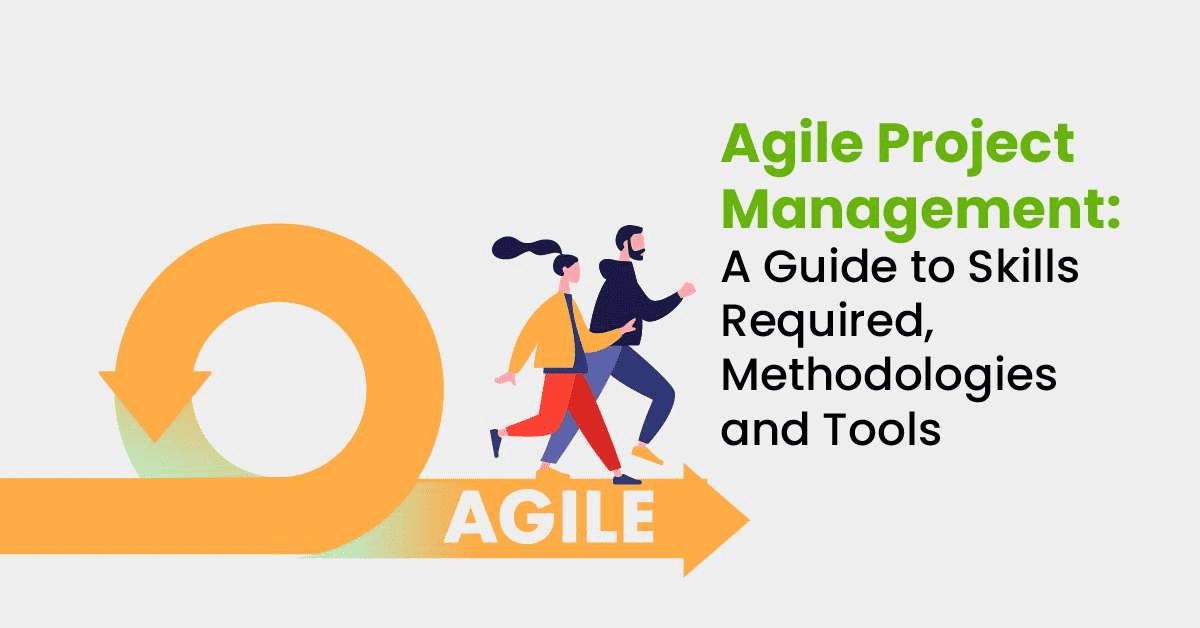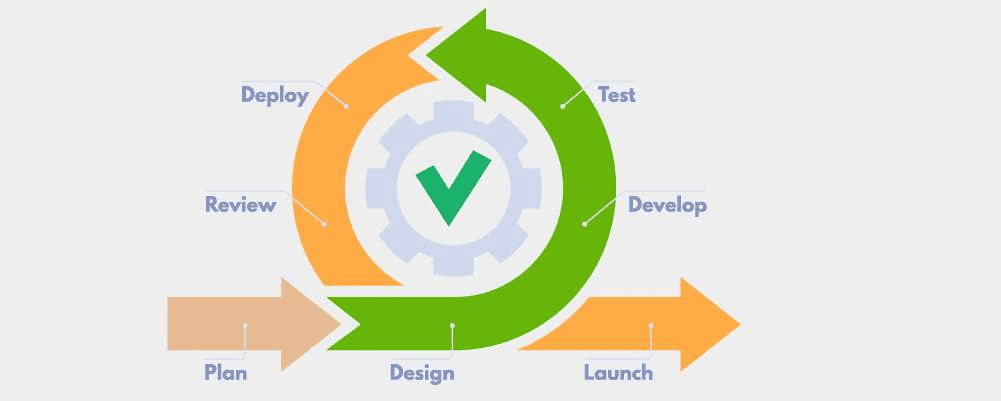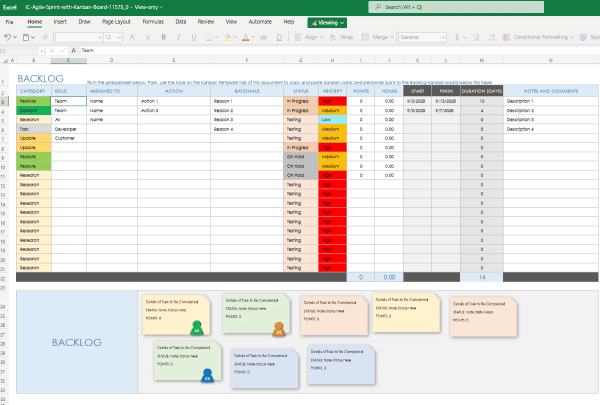
To understand the skills and tools in Agile Project Management software processes, you first need to learn about the basics.
Agile project management is a type of project management that works in short iterations rather than creating one big plan in traditional project management. Because of these short cycles, there is more opportunity to get feedback sooner when building software.
In short, it breaks down a large project into small and more manageable concepts. This means adapting to changes in your business becomes more streamlined and creates less risk.
One key difference between Agile project management and Traditional project management is the new approach to teamwork and small-scale project overviews. Giving more power to the entire team instead of escalating issues to a manager allows the team to work together on a project and prevent bottlenecking problems with one or two people.
Many people confuse Agile with Scrum, but Agile is more than that. The core method centers around frequent inspection and adaptation, breaking projects into smaller parts.
A Scrum is a subset of the Agile method, and we will go into more detail about what it means later. However, as we start off this guide, it’s important to remember that they are not the same thing.
Now that you have some background information, we can dive into the more complex concepts of this project management style.
What Is Agile Project Management?

If our short description was too technical, don’t worry. In this section, we will explain the concept of Agile Project Management in more detail.
The main focus of this management style is to break up the project into small cycles. This allows workers, developers, and the software itself to notice when improvements are needed. As the cycles are separated from each other, updating one area of the business won’t stop the whole production line from working.
The second focus is to talk to the client and allow them to give feedback at every step. This, again, means that errors can be noticed before they become too wrapped up in the product. This allows you to create high-quality products that match the client’s needs.
Teamwork, communication, and constant checks create high-quality products and increase productivity.
Values Of Agile
A manifesto was created for Agile Project Management to help create a clear understanding of its values.
To break it down, we have created 4 clear principles to follow.
Individuals And Interactions
Although technology is faster and more streamlined than an actual person, you still need a human to think of concepts and understand how to interact with customers. Agile understands this and ensures the workplace doesn’t rely too heavily on processes to create the correct outcomes.
This means that changes are more accessible to apply, as less structural technology must be rearranged.
Working Software
Ensuring that your software is working as it should is one of the most important aspects of Agile Project Management. If the workflow isn’t moving from one area to the next, then you are more likely to miss important details.
Putting a value on the rate of project flow helps developers stay on track and stops workers from becoming overloaded.
Customer Collaboration
Because your customers are your biggest asset, you need to make sure that they stay connected to your products. To keep them connected, they need to receive their product as expected. This means talking to them and allowing them to get involved with the creation process.
Instead of leaving them at the contract stage, creating the product, and then talking to them once it’s complete, your customers can see the product in motion. They will help them point out errors early and reduce time wasted on re-creations.
Responding To Change
The ability to change due to customers’ comments is just one way that Agile Project Management facilitates corrections.
In Traditional Project Management, changes mean stripping back the product or holding up the entire production line. This meant a change was avoided at all costs to prevent long periods of delays.
Because Agile Project Management separates each stage of the business into smaller sections, you can change one project without it affecting the productivity of another. This allows adaptation to happen easily and without harm to the business.
Agile Project Management: Methodologies

There are multiple methodologies in Agile Project Management, and we will go over the most commonly used ones here. These methods use Agile’s core values but create different frameworks to produce different results.
You can use more than one method in a business, but before you settle on a single concept, you should consider what options make the most sense for your organization.
The three most important are Kanban, Scrum, and Scrumban, but we will loosely touch on less common methodologies too.
Kanban
Originally created by Japanese culture, the Kanban method involves visualizing tasks on a whiteboard. Each task is written down in a workflow pattern so everyone can see where their work is in the company. This helps the team visualize the company as a whole and who is responsible for what.
This also means that everyone connected to a task can stay linked and up-to-date with its progress.
As everyone can see everyone’s task flows, it becomes clear where any bottlenecks are and what action needs to be taken.

Scrum
We have talked about Scrums already, but we haven’t gone into accurate detail. Scrum is when you break your project into small parts. These smaller parts are called Sprints, as we said before.
These Sprints need to be completed in 2 to 4 weeks from creation. This allows them to quickly add items to the working log and leave it quickly. Although the process is fast, it should still allow time for reflection and feedback.
The Scrum ceremonies normally go as follows:
- A Basic Sprint
- Sprint Planning
- This is needed when a backlog appears and is designed to help get back on track.
- Daily Scrum
- Tending to timeframes and giving out work.
- Sprint Review
- Ensuring everything is done correctly.
- Sprint Retrospective
- Seeing what you did well and what needs improvement.
Scrumban
As the name suggests, a Scrumban is a mixture between a Kanban and a Scrum. Using Scrum, the methodology creates flexibility while staying in touch with every team. And through the Kanban side, the teams have a visual to see the workflow and don’t feel overly burdened by the project as a whole.
This management methodology is an excellent option for teams hoping to move from one Agile method to another. For many people, a direct swap is too disruptive, but as all three methods come from the Agile collective, slowly switching between them is simple.
Extreme Programming
Also known as XP, this method focuses on continuous development. XP practices include Sprints as Scrum does. However, it also uses minor releases, simple designs, and continuous integration to continue the idea of small changes with constant checks.
Feature-Driven Development
Also known as FDD, the Feature-Driven Development methodology involves creating a new software model every two weeks. This model requires designs and development but also creates detailed documentation of your planning ability.
Using this method helps create a build that works to your exact requirements, and allows you to use software connected to your plans rather than the other way around.
Dynamic Systems Development Method
DSDM is designed to speed up rework. Rework is always needed in software, but this method focuses on control and speed while also ensuring that any changes are reversible.
Nothing is permanent in DSDM.
Crystal
Crystal methodology is a subsection of a subsection. There are multiple types of Crystals: Yellow, Orange, Red, and so on.
Regardless of your pick, the method prioritizes individuals and workers over processes and procedures. This means people can work in an environment that functions best instead of sticking to a rigid copy.
The colors represent the numbers in each group, and each color has a slightly different method to help create clarity.
Lean
Lean is actually a different methodology than Agile, however, they are often seen together due to their similarities (repeatable processes and collaboration work).
The differences are in waste management and deferring commitment. This means not planning things months in advance and not over-creating. The idea is to avoid wasting time, stop communication from slowing down, and remove unnecessary coding.
Agile Project Management Roles

There are normally 6 roles in Agile Project Management. You don’t need each of them in your organization, as they may not fit your framework. However, using these roles can help your business stay on track within its Agile methods.
Scrum Master
The role of the Scrum Master is to ensure that the Sprints stay on track. They also need to remove any issues and resolve any team challenges.
The term Scrum describes the framework that allows the team to work together. A Sprint is a short period when the Scrum team must rally together to complete their work. The Scrum is the team as a whole, while each group within the team will have Sprints to work on.
This means the Scrum Master is in charge of keeping the Scrum in communication with each other and ensuring the Sprints are organized as needed.
Product Owner
The Product Owner is the person in charge of each Sprint. They are responsible for that product, which means managing the team’s backlog, communicating between the customers and the teams, and managing the sprint rate.
A product Owner is like a team leader; however, they manage the product and the connection to the customers.
Agile Project Manager
A Project Manager is not the same as a Product Owner. A Project Manager looks at the day-to-day tasks that need to be managed. They are the connection to the product and the productivity of the team members in their scrum.
Where a Product Owner would take care of the connection between the customer and the product, the Project Manager focuses on the connection between the team member and the product.
Product Owners and Project Managers must work closely together to create a healthy balance.
Agile Portfolio Manager
An Agile Portfolio Manager works very similarly to a Traditional Portfolio Manager. They look at the products and goals of each Scrum and develop strategies to allow multiple teams to work together.
The difference is that through Agile, there is decentralization control, transparency, and the ability to be experimental. The transparent culture allows issues to come forward without fear of blame or punishment. Instead, the focus is on fixing the problem and moving forward.
As the Portfolio Manager isn’t part of any single team, they will not favor a group or expect more from them.
Engineering Manager
Engineering managers are essential to the flow of your team’s work. Their job is to remove bottlenecks and redirect buildups so the team can work efficiently. Delivering work on time and to a high standard.
This means focusing on the external issues that can affect a team’s workload. A good engineering manager knows that a healthy workforce cannot work at 100% regularly. This means ensuring the workload has ample slack to offset burnout.
Release Manager
The release manager’s main focus is on the management lifecycle. They track the different teams, production, and projects that work together to create a solution and ensure efficient communication and coordination between these groups.
Release managers ensure that their timelines, quality, and resources are all accounted for.
Agile Project Management: Skills Required

To work well in an Agile Project, you would need a couple of skills. These could be taught through classes, encouraged in culture, or reminded of in meetings.
T-Shaped Product Management
Each member of a team or Scrum should have the same knowledge of their primary subject.
This means that, as a Product Manager, you need to ensure that every team member covers the basics. To do this, you might switch job roles between team members to ensure that the basic knowledge isn’t lost or forgotten.
In this analogy’s “T” shape, the basic knowledge is the long horizontal line. The vertical line represents a deep knowledge of something more specific. Each member of the team should have their niche. This could be based on experience, ability, or specific expertise.
This allows the team to work together in Scrum and rely on each other’s specialized knowledge to resolve issues.
As everyone is an expert in basic knowledge, they can trust each other on the project, and with specialist knowledge of other subjects, they can ask each other for help when needed.
Strong Communication Skills
For anything in Agile to work as intended, each team member must communicate effectively. They need to feel comfortable displaying an issue, no matter the cause, and explaining how it impacts the project.
Because Agile Project Management is designed to show how each team member is doing and to quickly discuss the subject matter, explaining your reasoning is a key skill. With open communication comes the opportunity for miscommunication. Each team member must have strong communication skills to ensure this problem doesn’t occur frequently.
Able To Be Adaptive
Because Agile Project Management allows the workforce to adapt to change, people must also be adaptive.
This means learning new skills as they become needed, updating technology, keeping on top of those changes, and understanding that change doesn’t need to slow down progress.
Good Organization
Flexibility is a key factor in Agile Project Management, which means that linear working is unlikely in the workforce. To stay on top of your tasks and ensure that they align with other Scrums and Sprints, you need to become self-organized.
This means understanding your priorities and staying on top of them. Without this skill, it can be easy to leave details or jobs behind, creating issues for your team members.
Problem-Solving
One of the critical aspects of Agile project management is seeing a problem and figuring out how to solve it. Although finding solutions requires a team effort, having the right mindset to think proactively about the issue is necessary.
Although many people think they have excellent problem-solving skills, this mindset is created through an active need to solve issues.
To give a person this skill or help someone maintain it, it can be beneficial to create team days focusing on problem-solving, for example, escape rooms, riddles, and other fun team-building activities.
Time Management
As many Agile Projects are self-contained, each team member needs to be able to manage themselves to some degree. This means keeping an eye on the due dates of their work, the timeframes of their projects, and the team’s production rate.
For managers, this could also mean monitoring the movement between projects. If they are aware that a large project is coming their way, then managing their team to accommodate the large workflow is imperative.
Risk Management
One of the most significant risks in Agile Project Management is balancing the desire for the reward and the risk from the pursuit.
As a self-contained project, it can be easy for team members to pick up work that matches their interests, leaving undesirables behind. This can lead to delayed work and social friction. As a manager, the team should be re-directed if the group veers off course.
This leads to prioritization risks, where a manager fails to prioritize tasks correctly. This can lead to a backlog, bottleneck, or other delays.
Keeping an eye on the group dynamic and workflow can help prevent this risk.
Agile Ceremonies

Agile Ceremonies are regularly held meetings that aim to ensure that information is shared among the departments so that feedback can be spread to all involved people.
As part of the Agile ideals, communication is critical to stopping errors and continuing to make improvements.
For a successful Agile ceremony, you need to follow this format.
Daily Standups
Every day, the Agile Project Manager or the Scrum Master should present a 15-minute meeting. In this meeting, they need to provide the relevant information needed to continue their day and their projects.
They should explain what was done yesterday, what is being done today, and what problems they can see currently or in the future.
Having this conversation daily helps people see how changes are being made and what is expected of them.
Planning And Reviews
In Sprint planning, a one to two-hour meeting is needed to prepare a sprint, reduce the backlog, and keep the team on track.
The planning meeting must include priority work, placement, and technical preparations.
The scrum then ends with a review. In this review, the Scrum Master gives general feedback and re-lists the priorities and other last-minute small details.
Retrospectives
To ensure everyone is engaged with Sprint and aware of its progress, they need to analyze what went wrong and how to prevent it from happening again.
Picture a circle split into 4 sections – plan, do, check, act. The retrospective aspect of this circle is the checking part. Once the errors have been found, they are learned and noted so they can be avoided.
Refinement
When a Sprint ends, a refinement meeting is needed to add more information or details. You can break down the last remaining priorities, create a new estimate for the goal, and ensure everything is ready before committing to the work.
Agile Project Management: Tools

These Agile Project Management tools all use the Agile system to create clear and concise software that follows our mentioned ideas. Each has designs and specialties that could be perfect for your business.
Atlassian
Atlassian has a system called the Enterprise Initiative. Using the Agile system allows you to scale your business through flexibility. As your business grows and finds new areas to expand, the software grows, too. It moves with you to help respond to new demands quickly.
The automation is streamlined to eliminate repetitive tasks by completing them for you. All of this can be scaled up or down with ease, as the continuous integration software is designed to be seamless.
Monday.com
Monday.com is a cloud-based software. It is completely customizable and works both on a laptop and through a cell phone. Its main objective is to help teams visualize their data, track their projects and workflows, and allow for easy team collaboration.
Depending on preference, areas can be automated or manual, but the low-code framework makes adaptation easy.
Wrike
Wrike is another project management tool that helps manage multiple projects and teams. Its key features are the Kanban boards, interactive interface, customizable workflows, and ability to create cross-team collaborations.
This Agile Project Management system is best suited for businesses in the marketing sector. They can share real-time news, team calendars, and document collaborations while allowing their workflows to act automatically.
Wike can also track time spent on a project to help with billing and customer reports.
ClickUp
If you have a workplace that needs to complete its designs and tasks separately but then comes together at the end of the project, Clickup will be the best choice for you. It uses Agile methods to help cross-platform jobs work together on a goal.
Key performance indicators, which can be easily shared in bar charts, percentage circles, line crafts, and more, allow you to see real-time progress.
Its main feature is cross-functional collaboration, which means teamwork is easier as you leave comments and assign actions on a shared platform.
Kintone
We’re now entering a list of less famous but excellent Agile Project Management tools.
Kintone specializes in centralizing work. This means everyone can see how the project is developing and continuing, and you can easily share or track data from different teams.
All conversations about a project are also kept under that project heading. This means you don’t need to hunt for a message; instead, it stays with the correct data.
Zoho Sprints
Zoho Sprints’ primary focus is transparency. Their software is designed to keep a timeline, status update, and time between each action. This is meant to help eliminate unproductive activities and fully understand how long a task takes.
The system warns you when you are behind schedule while creating an average projection based on previously completed timelines.
They aim to create a seamless integration that mixes well with third-party apps such as Ask Jeeves and Microsoft Teams.
Nutcache
Nuctcache aims to help businesses struggling with organization and control. It wants to give small businesses the visuals necessary to produce predictable profitability. To this end, it showcases graphs and projections automatically.
Many of Nutcache’s systems are automatic, such as managing hours completed by employees, invoicing clients, distributing workloads, and monitoring progression.
They also have a system that can help businesses with their budgeting needs, creating predictions based on real-time revenue.
Ravetree
Ravetree uses both Agile and Waterfall methodologies. This means that everything is clearly divided into small projects to make them easier to manage. However, when one project is completed, it automatically gets pushed down the waterfall to the next stop.
Mixing these two concepts is rather tricky, as one is a circular system, and the other is a linear system. However, Ravetree uses both methodologies to the best of its ability while allowing its customers to cherry-pick the best aspects that work for their business.
Pivotal Tracker
Pivotal Tracker is designed to make organizations more accessible and to help teams focus on their projects. It quickly flags priorities when processes have a backlog.
The workflow is created in a simple visualization that makes changes easy to understand. The visualization can be adapted as your plans grow and change. Everything is clear, as transparency is key in their scheme.
This system is a little clunkier than some of the similar software available. However, you can try it out with their “30 days free” incentive.
Nostromo
Nostromo means “shipmate” in Italian and is also the name of a famous fiction book about a charismatic sailor who loses his mind on a deserted island. He risks his life for fame and fortune and fails in the process. The story ends with him getting shot by a friend who mistakes him for a trespasser.
Following the story of a failed businessman isn’t a great start to your company dynamic.
But back to the software, Nostromo’s main aim is to help with time management and focus in the workplace and organization. It does this through clear labeling, transparency, and bar graphs.
MeisterTask
MeisterTask uses a Kanban-style version of the Agile philosophy. Their main goal is to create an organized management system that gives you a clear overview of your tasks.
Everything is organized into timelines, and your reports are automatically filtered into priority listings.
This system works well on your cell phone as well as a desktop computer. It uses color coding to help make trends and expectations easy to read at a quick glance.
If you use the mobile software, you will get notifications when tasks are completed.
Summary
Agile Project Management is a type of software management style. It prioritizes short cycles of work schedules to break down large projects into more manageable concepts.
The main ideas of Agile are to keep communication open through multiple meetings, make a visual representation of work to allow easy-to-follow management, and avoid time-wasting which can occur during linear project management styles. As every department can see each other’s workflow but are not directly involved in them, each manager can understand the team’s work rate and can adapt without affecting other departments.
Shane Drumm, holding certifications in PMP®, PMI-ACP®, CSM, and LPM, is the author behind numerous articles featured here. Hailing from County Cork, Ireland, his expertise lies in implementing Agile methodologies with geographically dispersed teams for software development projects. In his leisure, he dedicates time to web development and Ironman triathlon training. Find out more about Shane on shanedrumm.com and please reach out and connect with Shane on LinkedIn.